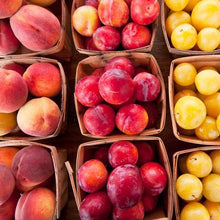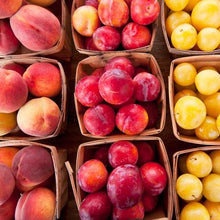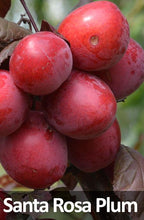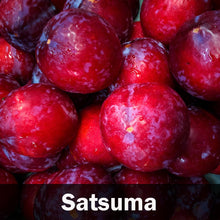3 of the Best Plum Varieties from One Amazing Tree
Limited Space? Grow 3 Types of Plums on 1 Tree
When it comes to beautiful plum trees and the mouth-watering fruit they bear, there are several great varieties from which to choose from. If you only have space for just one, well, the decision is a tough one. So, to make your selection easier, we decided to take three of the very best cultivars available, including the Santa Rosa, Satsuma, and the Beauty, and graft them together to create one amazing plum tree: our 3-in-1 Plum!
Beautiful Tree for all Seasons
The 3-in-1 Plum tree erupts with color early in spring, flaunting pale pink and/or white blossoms that are fragrant and lovely against a backdrop of vibrant green foliage. These three cultivars bloom at varying intervals, depending upon your region, so you'll have beautiful flowers for weeks on end. While the flowers and the fruit are a magnificent sight, this tree also provides terrific autumn color too! Though this magnificent tree is self-fertile, you'll want to plant more than one for the aesthetic value alone.
Easy to Grow and Manage
Maturing to heights of just 15-20 feet with a similar spread, the 3-in-1 Plum fits nicely into almost any landscaping design, and with a tree of this stature, your harvest will be trouble-free. Hardy in zones 5-9, the 3-in-1 Plum is low-maintenance, requiring very little care. A vigorous grower, this exceptional darling thrives in partial to full sun and is disease resistant and tolerant of dry, hot conditions.
Order Now
Our nursery staff is trained to perform specialized pruning of these 3-in-1 Plum trees, to provide you with the highest producing fruit trees available. This versatile beauty is a must-have for your backyard fruit orchard. Order yours today, while supplies last.
Planting & Care
A unique addition to your landscape, the multi graft plum (Prunus sp.) tree will provide you with loads of multiple varieties of plums with only one tree. Only reaching 15-20 feet tall and 15 feet wide it is compact enough for a small yard and the fruit is more easily harvested. Growing in zones 5-9, the tree is cold tolerant down to -10 degrees and requires approximately 600 chill hours (depending on the variety of plum), so most varieties will produce, even in warmer climates. This tree provides several months of interest also as it blooms in early spring, produces fruit in mid to late summer, and has excellent fall color. Multi graft trees are self-fertile so you only need the one tree for fruit!
Choosing a location: All plum trees need a full sun exposure location so be sure to pick a bright spot for the tree's new home. Well draining, sandy soil is highly recommended with a pH range from 5.5 to 6.5 (which can be easily determined with an inexpensive soil testing kit from your local nursery/big box store). If possible, plant the tree in a South or West location to cut back on the wind which in turn will assist the tree in setting fruit.
Planting directions:
1) Prepare your hole by digging it three times as wide as the root ball and just as deeply.
2) Gently comb the root ball freeing up any compacted roots and place the tree.
3) Backfill the hole partially, pressing down gently as you go along and water to settle the soil.
4) Once the hole has been completely filled, add a layer of organic mulch around the tree to help conserve water. Do not let the mulch touch the trunk of the tree as this can promote rot and fungus.
Watering: Water your tree generously weekly, twice a week for the first growing season to help promote the growth. Deep watering encourages the roots to extend more deeply into the soil which in turn makes the tree more drought resistant. For young trees, deep watering with a little over two gallons of water works well whereas adult trees will require around 8 gallons for each watering. If the edges of the tree’s leaves appear to be turning brown or wilting, then the tree is not receiving enough water. The bark at the base of the trunk will change from a light brown to dark brown (or black-ish) color if it’s receiving too much water.
Pruning: Give your tree a full year to get situated in its new home before attempting to prune. Young plum trees are typically pruned in the late winter to early spring seasons before buds begin to break. This will cut back on the possibility of “silver leaf disease” attacking the tree. More established plum trees will benefit from a midsummer pruning. Pruning isn’t very difficult but a necessity to “cut back” on broken limbs from heavy fruit production. Take off about 20% of the previous year’s growth with cuts at a 45-degree angle. Use a sterilized cutting tool (rubbing alcohol works perfectly) leaving the upright, vigorous branches plenty of space for light to penetrate.
Fertilizing: There are a couple of steps for proper fertilizing of your plum tree to ensure a healthy growing season. Young trees that are three years or younger will benefit from about a half cup of balanced 10-10-10 fertilizer formula applied once in around mid-April and again in early June. More established plum trees will require one annual application of the same balanced formula mid-April. Use 8 ounces for every year of the tree’s age. Fertilizer can burn the roots of younger trees so instead of taking the chance with chemicals, improve your soil’s fertility by amending compost into it.
Plum trees that are fertilized properly should grow about 1 foot to 18 inches per year. Symptoms of over-fertilizing can include leaf scorching and excessive growth. If you’re noticing these issues then reduce the amount of fertilizer for the following year. Always be sure to water DEEPLY after every fertilizer application and avoid fertilizer getting too close to the trunk.







